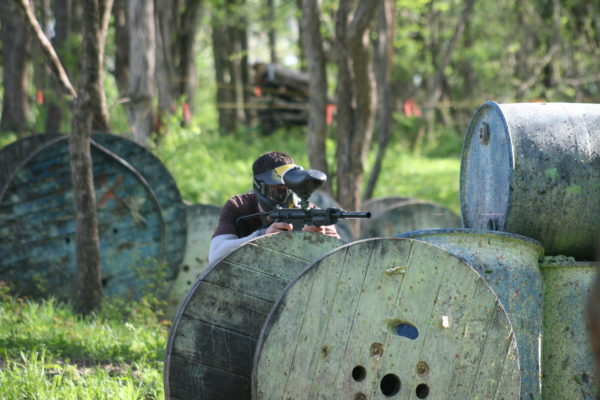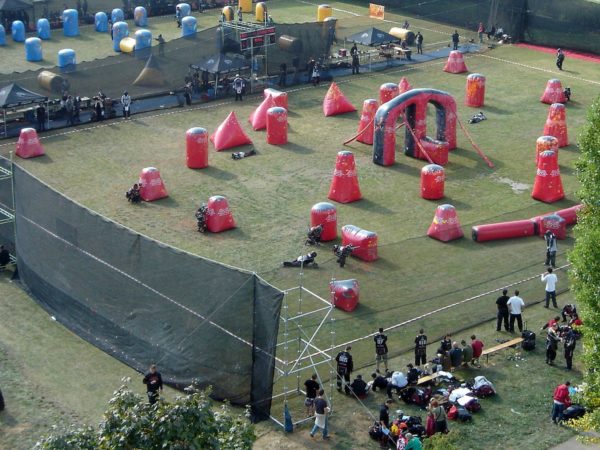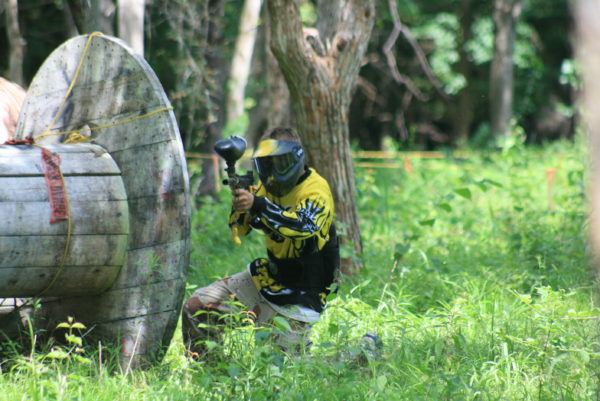The Two Biggest Ways to Play Paintball: The Difference Between Woodsball & Speedball
Many newcomers to the sport may not realize is that there are different styles of play, each with its own distinct characteristics, rules, and strategies. Two of the most popular styles are Woodsball and Speedball. While both fall under the umbrella of paintball, the experiences they offer are significantly different. In this article, we will break down the key differences between Woodsball vs Speedball, and help you decide which style might suit your playstyle best.
Whether you’re a beginner curious about the paintball game types or a seasoned player looking to refine your understanding, this article will guide you through everything you need to know about these two thrilling paintball formats.
What Is Woodsball?
Woodsball, also known as scenario or tactical paintball, is a form of paintball played primarily in outdoor, natural environments. The name itself is derived from “woods,” as the games are often set in wooded or forested areas. This style of play is designed to simulate military or tactical combat scenarios, making the environment a crucial element of the game.
Key Features of Woodsball
- Terrain & Environment Woodsball games take place in expansive, outdoor environments that incorporate natural elements such as trees, bushes, hills, and water bodies. Sometimes, fields will feature man-made structures like forts or bunkers to add a layer of complexity to the game.
- Gameplay Style Woodsball tends to be slower-paced and emphasizes strategy and tactics. Players must navigate through the terrain carefully, using cover and concealment to avoid being spotted by the opposing team. The larger playing field allows for more thoughtful planning, long-range engagements, and ambushes.
- Game Objectives Woodsball often includes varied and intricate objectives beyond just eliminating opponents. Missions can involve capturing a flag, defending a base, or rescuing a “hostage.” These objectives encourage teamwork, coordination, and long-term planning, making the game more strategic and immersive.
- Equipment Woodsball players often use markers (paintball guns) designed for accuracy and range, as the larger playing field lends itself to long-distance engagements. Players might also carry additional equipment such as camouflage gear, tactical vests, and paintball grenades to better simulate a combat environment.
- Duration Woodsball games tend to last much longer than Speedball matches. Some Woodsball events can go on for several hours, while larger scenario games may even span multiple days, making stamina and endurance key factors.
What Is Speedball?
Speedball, on the other hand, is a form of paintball that is played in a much smaller, enclosed field, typically marked with inflatable bunkers and obstacles. It is the fast-paced, competitive cousin of Woodsball, with a focus on quick reflexes, agility, and teamwork.
Key Features of Speedball
- Terrain & Environment Speedball is played in a flat, open field with strategically placed inflatable bunkers and obstacles. These bunkers are brightly colored and symmetrically arranged to ensure balanced gameplay for both teams. The fields are much smaller than those used in Woodsball, making it easy for players to see their opponents at almost all times.
- Gameplay Style Unlike the slow, tactical nature of Woodsball, Speedball is extremely fast-paced. The smaller field means there is little room to hide, and players must rely on quick reflexes, sharp shooting, and teamwork to outmaneuver the opposing team. Speedball emphasizes action and intensity, with matches often lasting only a few minutes.
- Game Objectives Speedball games usually follow a straightforward objective—eliminate the opposing team or capture the flag. Because of the smaller field size and fewer players, the focus is primarily on rapid-fire engagements and moving as a cohesive unit to overpower the enemy team.
- Equipment Speedball markers are designed for speed and efficiency. They tend to be lightweight and capable of firing paintballs rapidly. Players also wear bright, easily identifiable uniforms, making concealment unnecessary. Instead, the focus is on mobility, firepower, and communication.
- Duration Speedball games are short and intense, usually lasting anywhere from 5 to 10 minutes. Tournaments or matches might involve multiple rounds, with teams competing in a best-of series format.
Key Differences Between Woodsball and Speedball
Now that we’ve covered the basic definitions of Woodsball vs Speedball, let’s dive deeper into the differences between these two paintball game types. Each offers a unique experience, and the choice between them often comes down to personal preference.
1. Field Size and Layout
- Woodsball: Played in large, natural settings that can span several acres, Woodsball fields are often irregular in shape. This creates a dynamic environment where players can use the terrain to their advantage.
- Speedball: Speedball fields are small, symmetrical, and designed for balance. They feature artificial inflatable bunkers placed in fixed positions, which are arranged to encourage fast-paced action.
In Woodsball, you’ll have plenty of room to strategize, sneak, and find cover in the natural environment. In Speedball, it’s all about moving quickly and adapting to the symmetrical layout.
2. Pacing of the Game
- Woodsball: With its expansive fields and emphasis on tactics, Woodsball matches are slower and can last much longer. Players often spend a significant amount of time positioning themselves or devising strategies.
- Speedball: The confined space and close-quarters combat in Speedball make for lightning-fast matches. Players are constantly on the move, and the pace is relentless from start to finish.
Woodsball allows for more breathing room and strategy, while Speedball tests your ability to think and act under pressure in a much shorter timeframe.
3. Strategy vs Reflexes
- Woodsball: The large, complex environment of Woodsball rewards players who can think strategically and work as a team. Stealth, patience, and communication are vital to success.
- Speedball: Speedball, by contrast, rewards quick reflexes, accuracy, and fast decision-making. There is little time to plan elaborate strategies, so players must rely on their instincts and ability to communicate effectively in real-time.
If you enjoy outsmarting your opponents and laying ambushes, Woodsball is the game for you. If you prefer high-speed, adrenaline-pumping action where every second counts, Speedball is your arena.
4. Markers and Gear
- Woodsball: Players typically use heavier, more tactical markers that focus on range and precision. Woodsball markers may also include accessories like scopes, stocks, or larger hoppers to simulate military gear. Players often wear camouflage to blend into the natural environment.
- Speedball: Speedball markers are lightweight, compact, and optimized for rapid-fire. Players also tend to use brightly colored jerseys and pants, as concealment is not a priority. Speedball guns prioritize speed, firing several paintballs per second.
In Woodsball, your gear is all about endurance and stealth. In Speedball, it’s about speed, efficiency, and maximum firepower.
5. Skill Development
Both Woodsball and Speedball develop different types of skills that can benefit you in various aspects of paintball—and even in everyday life.
- Woodsball: You’ll hone your strategic thinking, problem-solving, and team coordination skills. The slower pace gives you time to consider your options and plan long-term strategies with your teammates.
- Speedball: You’ll develop quick decision-making abilities, reflexes, and precision shooting. Because of the fast pace, you must learn to react immediately to changing situations.
Each game format offers a unique way to improve different skill sets, and many experienced paintball players enjoy switching between the two styles to develop a well-rounded approach.
Which Style Is Right for You?
When deciding between Woodsball vs Speedball, consider what you’re looking to get out of your paintball experience. Here are a few questions to ask yourself:
- Do you prefer slow, strategic gameplay or fast, high-energy action?
-
- If you like to take your time, think through your moves, and rely on stealth, Woodsball might be your preferred choice.
- If you thrive on high-speed competition, quick reactions, and aggressive play, Speedball will be more up your alley.
- Do you enjoy outdoor environments or controlled, artificial fields?
-
- For players who love the outdoors and enjoy navigating through natural terrain, Woodsball offers a more immersive, scenario-based experience.
- If you prefer a controlled environment where skill and balance determine the outcome, Speedball provides that with its symmetrical and predictable field layout.
- Are you looking for an intense workout or a more leisurely day out?
-
- Speedball will challenge you physically and mentally in a very short time. It’s intense and action-packed, making it a great option for those looking for a quick, adrenaline-filled game.
- Woodsball can be physically demanding as well, but the longer games allow for a more relaxed pace, giving you time to rest between encounters.
- Are you playing casually with friends or competitively in tournaments?
-
- Woodsball is ideal for casual play with friends or for participating in large-scale scenario events that span hours or even days.
- Speedball is often more competitive and is the format used in professional paintball leagues. If you’re interested in competitive paintball, Speedball is the way to go.
The choice between Woodsball vs Speedball depends on your preferences and what kind of experience you’re after. If you enjoy strategy, long-term planning, and immersive environments, Woodsball will provide a deeply satisfying experience. On the other hand, if you crave fast-paced, high-energy action with an emphasis on skill and teamwork, Speedball will keep you on your toes.
Many players enjoy switching between the two styles, as both offer unique challenges and rewards. Whether you’re stalking through the woods or diving behind inflatable bunkers, paintball is all about having fun, testing your limits, and building camaraderie with your teammates.
If you’ve never tried both types of paintball, why not give each a shot? You might discover a new favorite way to play!




